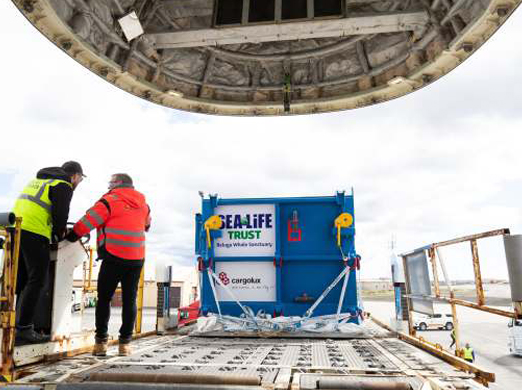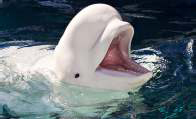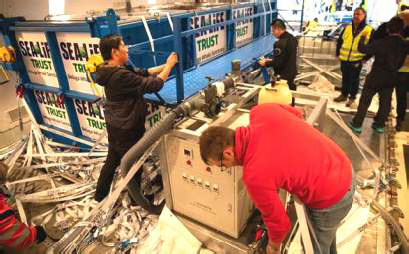Cargolux Airlines Nature's friend
For years now, Cargolux had taken a number of ethical measures protecting animal rights. It had banned a number of controversial commodities such as lion bone or hunting trophies from shipment across its network.
Cargolux Airlines made headlines in June when it successfully transported two captured Beluga whales—Little Grey and Little White—from China to Iceland. They traveled some 6,000 miles to claim freedom for the first time after more than 12 years in captivity in a Shanghai amusement park entertaining countless spectators every day to their new home, the world’s first open water sanctuary for Beluga whales. Their move heralds a major step to global efforts to protect beluga whales and other wildlife in captivity.
Created by the global marine wildlife charity, Whale and Dolphin Conservation (WDC), the SEA LIFE TRUST Beluga Whale Sanctuary is one of the biggest developments in captive whale and dolphin care and protection in decades and the first of its kind to be created for cetaceans.
 The Luxembourg – based Cargolux Airlines , Europe ‘ s leading all-cargo airline with its modern and efficient fleet consisting of 14 Boeing 747-8 freighters and 16 Boeing 747-400 freighters, made the epic journey possible with careful planning, technical experts and time-tested capabilities to undertake special projects.
The Luxembourg – based Cargolux Airlines , Europe ‘ s leading all-cargo airline with its modern and efficient fleet consisting of 14 Boeing 747-8 freighters and 16 Boeing 747-400 freighters, made the epic journey possible with careful planning, technical experts and time-tested capabilities to undertake special projects.
No to hunting trophies
Cargolux Airlines CEO Richard Forson, a first generation South African-Chinese, told Air Cargo Update nature is something close to his heart growing up in the African continent communing with animals, wildlife & their natural environment.
In an interview in Munich , Germany where Cargolux participated in Air Cargo Europe 2019, Forson shared there’s a need for a global movement to protect more nature and wildlife.
“I was born and bred in South Africa,” Forson shared. “I’ve seen the decimation of the elephant population. For example, elephants are killed for fashion items. Snakes are killed to make handbags and other fashionable items,” he said lamenting the practice’s impact to the wildlife’s population that if not changed would make them extinct.
 Illegal wildlife trade is indeed a serious crime threatening the world’s wildlife population. It is in fact a multibillion business and is today the world’s top fourth transnational crime.
Illegal wildlife trade is indeed a serious crime threatening the world’s wildlife population. It is in fact a multibillion business and is today the world’s top fourth transnational crime.
The United Nations estimated the value of illegal wildlife trade in 2016 as somewhere between USD7-23 billion annually while the Interpol recently pegged its value at USD20 billion. Africa appears to be the most vulnerable for animal poaching devastating its wildlife populations, threatening their survival for years to come.
For years now, Cargolux had taken a number of ethical measures protecting animal rights. It had banned a number of controversial commodities such as lion bone or hunting trophies from shipment across its network.
The airline is also a signatory to the United for Wildlife International Taskforce on the Transportation of Illegal Wildlife Products to fight illegal animal trafficking. And as an advocate for animal welfare, Cargolux reviews each demand for animal transport carefully to ensure ethical practices are upheld throughout the transportation chain.
Sustaining Growth
Forson first came to work for Cargolux in 2012. By 2016, he was tapped to lead the company which has more than 2,000 employees world wide . Remarkably , the company made unprecedented financial growth when he assumed his post and the momentum keeps going.
“I think a lot of it depended on the market and also being in a position to work as a team,” Forson modestly said when asked how he managed to bring major profits within just a short period of time.
“It started in 2016, the fourth quarter, it was really a surprise for every one in the industry . I t improved in 2017 and 2018 was also a very good year for us.”
Cargolux’s consolidated net profit after tax for 2018 amounted to USD211.2 million, nearly double its 2017 profit of USD122.3 million despite a global softening in market demand in the second half of 2018.
The company attributed its good performance to increased demand for its transport solutions with the Cargolux Group producing a total of 8,409 FTKs across its worldwide network while the available ton kilometers grew to 12,375 million resulting in an overall load factor of 67.9% for the year.
Forson also credited their growth t o “ strong focus of the management on their capacities and yields, increased demand for specialized shipments, a record year for our charter division and the diversification into offering ACMI solutions all contributed to the performance achieved” and their dedicated staff.
“No one is more important than the other. If I don’t have someone to load in the aircraft, we won’t be able to fly,” Forson said of their operations. “It’s a 24/7 365 job as far as I’m concerned, day or night it’s up in the air (the freighters).”
He added that he continues to encourage employees to work harder to make Cargolux a success. “I tell them if they want sustainable jobs then help me make Cargolux a sustainable business from a financial perspective, from an environmental perspective while keeping our social responsibility towards employees and the community that we operate in.”
The CEO said it helps that Cargolux continues to invest on people, technology, facilities and infrastructure making their work easier and more efficient for customers who demand quality service.
“To be sustainable we have to be agile. We have to be flexible. And to do that you have to be ready to change in a moment’s notice. You have to accept that there will be some issues along the way but the important thing for me is to realize that there are solutions available
for those issues,” said Forson who has been in the aviation industry since 1990 working his way up to become the CEO of one of the world’s biggest cargo carriers.
Cargolux plans to hire more people while taking major transformations like completely overhauling its IT system to streamline processes, synergize teams internally and enhance customer experience.
 Forson said these are all part of the company’s lean and green philosophy and on going digitalization initiatives.
Forson said these are all part of the company’s lean and green philosophy and on going digitalization initiatives.
“We’re now taking it to the next step. A lot of things will be automated,” he said.
Cargolux seems to be heading for another busy year. The cargo carrier announced in June it’s serving Jakarta , the 16th destination in its Asia-Pacific network. The once a week flight leaves the Grand-Duchy on Sunday and arrives in Jakarta on Monday. The rotation then continues through Hong Kong and Ashgabat before returning to Luxembourg on Tuesday morning.
On July 1, it launched a third weekly frequency to Xiamen to meet growing customer demand. The new service , C V 9 7 2 1 i s operated every Monday morning, departing Luxembourg at 8:10 a.m. with arrival in Xiamen on Tuesday at 4:40 a.m.
The return flight, CV9731, is scheduled to leave Xiamen at 6:15 a.m. and is routed through Los Angeles before returning to Luxembourg where it lands at 6:15 a.m. (All times provided are local), cementing Cargolux ‘ s strong position in China and on transpacific trade lanes
Little Grey and Little White’s epic journey back to the wild
“The world’s first whale sanctuary represents a pathway to the end of the keeping of whales and dolphins confined for entertainment. We are proud to be a partner of this important project that will improve welfare for these belugas, and show the world that there is an alternative to whale and dolphin captivity.”
 Little Grey and Little W h i t e continues to do well after safely landing in Iceland on June 19 following a 6,000 mile flight from China.
Little Grey and Little W h i t e continues to do well after safely landing in Iceland on June 19 following a 6,000 mile flight from China.
The SEA LIFE Trust says the two captive whales will continue to be monitored while in the sanctuary in a natural bay on Heimaey, one of the Westman Islands, located off the southern coast of Iceland.
Throughout their 11.30-12-hour flight journey, Little Grey and Little White were monitored by their care teams to ensure they remained safe and comfortable. A Cargolux engineer and a team of global veterinary expert swith experience i n transporting marine mammals were also on board, to guarantee the whale’s welfare, whilst ensuring flight safety requirements were upheld.
“We’re absolutely delighted Little Grey and Little White have safely touched down in Iceland. This is a complex but inspiring project and we’ve been working with the whales for months helping to prepare them for travelling to their new home,” said Andy Bool, Head of SEA LIFE Trust.
“We’ll continue to carefully monitor the whales but we’re pleased with their overall progress and welfare checks, which have been taking place throughout the relocation. The co- ordination of this project has been down to so many people and we’re extremely grateful for all their hard work, and are thrilled this epic journey has gone as planned.”
 The 747-400ERF freighter plane was welcomed onto the tarmac with a ceremonial water salute from two fire trucks firing a water arc over the plane, in celebration of Iceland’s newest residents’ safe arrival.
The 747-400ERF freighter plane was welcomed onto the tarmac with a ceremonial water salute from two fire trucks firing a water arc over the plane, in celebration of Iceland’s newest residents’ safe arrival.
Richard Forson, Cargolux President and Chief Executive Officer, added: “We are delighted that Little Grey and Little White enjoyed a seamless journey onboard our Cargolux aircraft. The success of this undertaking is the reflection of the dedication and commitment of teams
across all of our organisations who worked tirelessly to make this happen.
“This epic relocation required complex logistical efforts, and we are proud to have been part of this incredible journey. We hope that Little Grey and Little White rapidly adapt to their new home and that their story will serve as a precedent for other cetaceans held in captivity.”
Created in partnership with global marine wildlife charity, Whale and Dolphin Conservation (WDC), the SEA LIFE TRUST Beluga Whale Sanctuary is one of the biggest developments in captive whale and dolphin care and protection in decades and the first of its kind to be created for cetaceans. “Having been originally involved in discussions about a sanctuary with SEA LIFE 20 years ago, and having helped with this beluga whale project from the beginning, WDC is naturally very excited to be part of the welcoming committee for Little White and Little Grey as they touch down in Iceland,” Cathy Williamson, Whale and Dolphin Conservation’s End Captivity Programme Policy Manager concluded.
“The world’s first whale sanctuary represents a pathway to the end of the keeping of whales and dolphins confined for entertainment. We are proud to be a partner of this important project that will improve welfare for these belugas, and show the world that there is an alternative to whale and dolphin captivity.”
The sheltered bay will be the world’s first open water sanctuary for beluga whales in what is a ground-breaking
global marine welfare project. The bay, which measures approximately 32,000 sqm with a depth of up to 10m has been chosen to provide a more natural sub-Arctic environment and wilder habitat for these amazing whales to call home.










